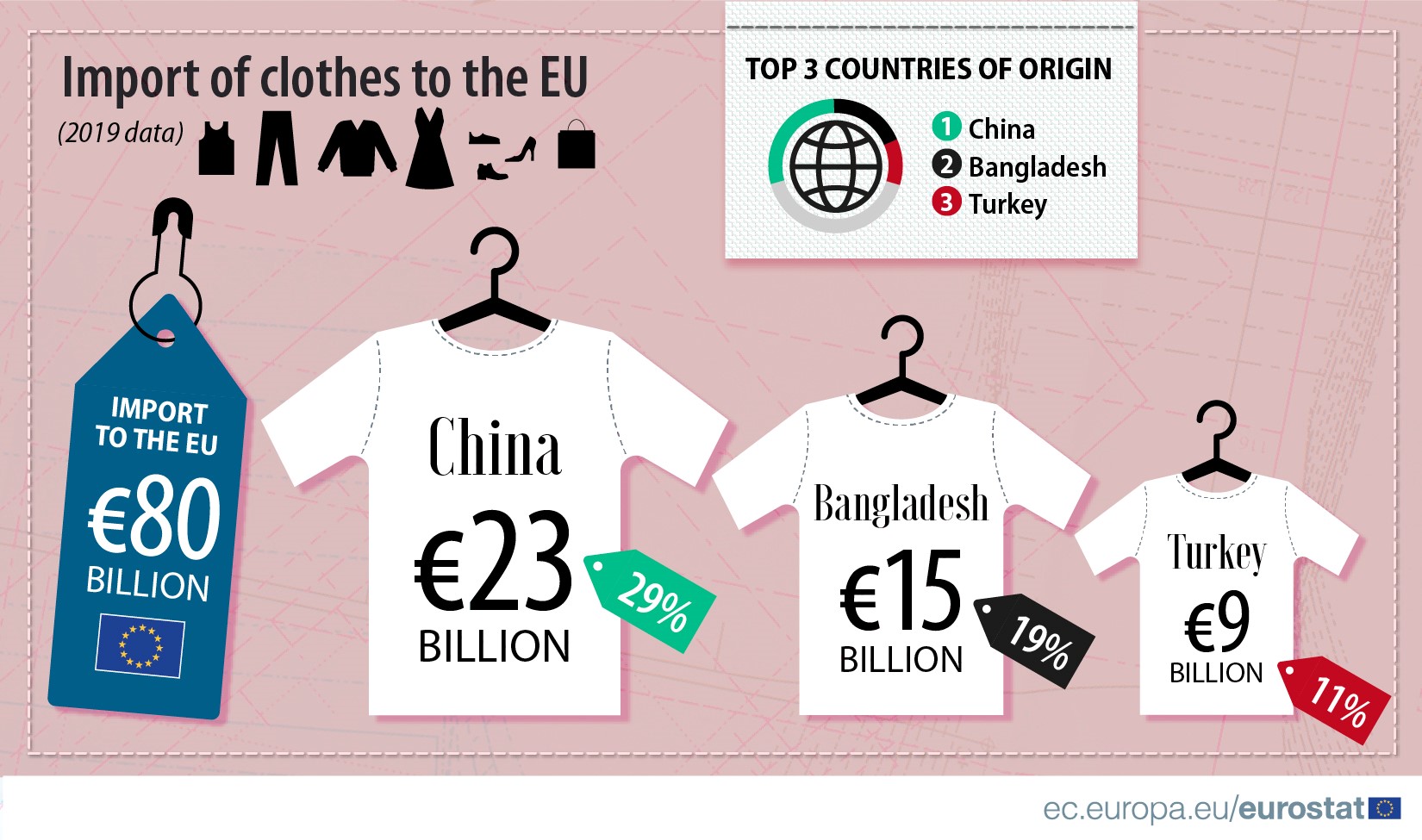Where do our clothes come from? The EU Member States imported clothes worth €154 billion in 2019, just over half of which came from non-EU Member States (52%, or €80 billion). Over the last decade, imports of clothing to the EU Member States increased in value by 62%.
€115 billion of clothes were exported by the EU Member States, the majority of which went to other EU Member States (69%, or €79 billion). This represents a 68% increase in the value of EU Member States’ intra-EU exports since 2009.
Although trade in textiles has increased significantly over the last decade, factory closures and transport restrictions related to the current coronavirus pandemic may affect this trend.
Germany, the largest importer of clothes
In 2019, almost €19 billion-worth of clothes were imported by Germany from non-EU Member States (23% of total extra-EU imports of clothes imports by value). This makes Germany the largest EU importer of clothing from non-EU countries, ahead of Spain (€13 billion, 16%), France (€11 billion, 14%), the Netherlands (€10 billion, 13%) and Italy (€8 billion, 10%).
China, the main origin of imported clothes
Imports of clothes from non-EU countries came mainly from China (€23 billion, or 29% of total extra-EU clothes), Bangladesh (€15 billion, 19%) and Turkey (€9 billion, 11%), followed by United Kingdom (€5 billion, 6%), India (€4 billion, 5%), Cambodia and Vietnam (both €3 billion, 4%).
Italy, largest clothing exporter
Among EU Member States, Italy exported clothes worth €12 billion to non-EU Member States in 2019 (34% of total extra-EU exports of clothes by value). This makes Italy the largest extra-EU exporter of clothes, ahead of Germany (€6 billion, 16%), Spain (€5 billion, 15%), France (€4 billion, 13%) and the Netherlands (€2 billion, 5%).

Where do our clothes come from? The EU Member States imported clothes worth €154 billion in 2019, just over half of which came from non-EU Member States (52%, or €80 billion). Over the last decade, imports of clothing to the EU Member States increased in value by 62%.
€115 billion of clothes were exported by the EU Member States, the majority of which went to other EU Member States (69%, or €79 billion). This represents a 68% increase in the value of EU Member States’ intra-EU exports since 2009.
Although trade in textiles has increased significantly over the last decade, factory closures and transport restrictions related to the current coronavirus pandemic may affect this trend.
Germany, the largest importer of clothes
In 2019, almost €19 billion-worth of clothes were imported by Germany from non-EU Member States (23% of total extra-EU imports of clothes imports by value). This makes Germany the largest EU importer of clothing from non-EU countries, ahead of Spain (€13 billion, 16%), France (€11 billion, 14%), the Netherlands (€10 billion, 13%) and Italy (€8 billion, 10%).
China, the main origin of imported clothes
Imports of clothes from non-EU countries came mainly from China (€23 billion, or 29% of total extra-EU clothes), Bangladesh (€15 billion, 19%) and Turkey (€9 billion, 11%), followed by United Kingdom (€5 billion, 6%), India (€4 billion, 5%), Cambodia and Vietnam (both €3 billion, 4%).
Italy, largest clothing exporter
Among EU Member States, Italy exported clothes worth €12 billion to non-EU Member States in 2019 (34% of total extra-EU exports of clothes by value). This makes Italy the largest extra-EU exporter of clothes, ahead of Germany (€6 billion, 16%), Spain (€5 billion, 15%), France (€4 billion, 13%) and the Netherlands (€2 billion, 5%).

































Discussion about this post